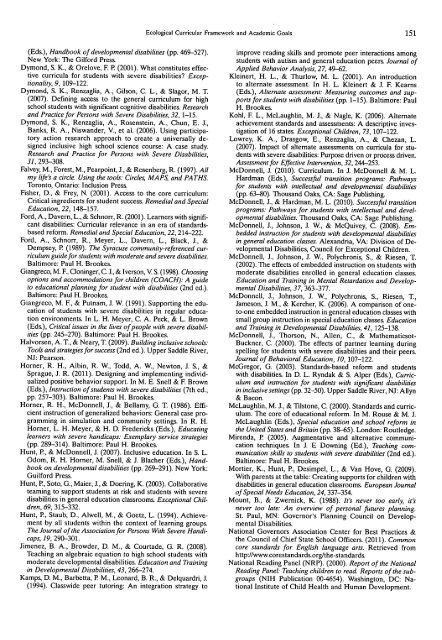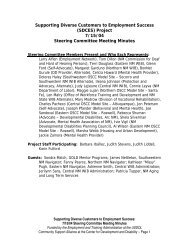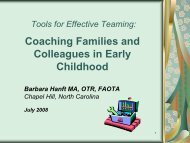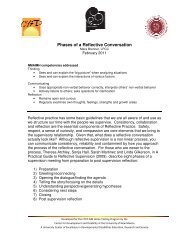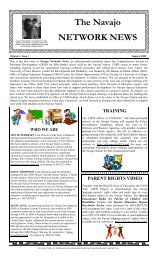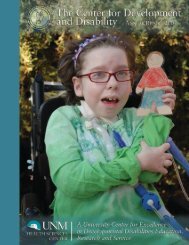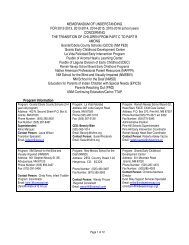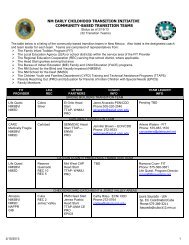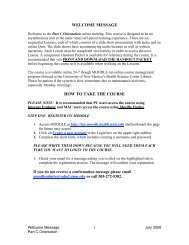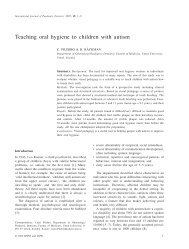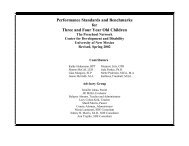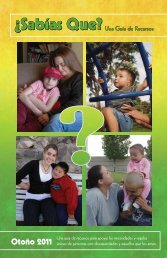Reconciling an Ecological Curricular Framwork Focusing on Quality ...
Reconciling an Ecological Curricular Framwork Focusing on Quality ...
Reconciling an Ecological Curricular Framwork Focusing on Quality ...
You also want an ePaper? Increase the reach of your titles
YUMPU automatically turns print PDFs into web optimized ePapers that Google loves.
(Eds.), H<str<strong>on</strong>g>an</str<strong>on</strong>g>dbook of developmental disabilities (pp. 469-527).<br />
New York: The Gilford Press.<br />
Dym<strong>on</strong>d, S. K., & Orelove, E P (2001). What c<strong>on</strong>stitutes effective<br />
curricula for students with severe disabilities? Excepti<strong>on</strong>ality,<br />
9, 109-122.<br />
Dym<strong>on</strong>d, S. K., Renzaglia, A., Gils<strong>on</strong>, C L., & Slagor, M. T.<br />
(2007). Defining access to the general curriculum for high<br />
school students with signific<str<strong>on</strong>g>an</str<strong>on</strong>g>t cognitive disabilities. Research<br />
<str<strong>on</strong>g>an</str<strong>on</strong>g>d Practice for Pers<strong>on</strong>s with Severe Disabilities, 32, 1-15.<br />
Dym<strong>on</strong>d, S. K., Renzaglia, A., Rosenstein, A., Chun, E. J.,<br />
B<str<strong>on</strong>g>an</str<strong>on</strong>g>ks, R. A., Nisw<str<strong>on</strong>g>an</str<strong>on</strong>g>der, V., et al. (2006). Using participatory<br />
acti<strong>on</strong> research approach to create a universally designed<br />
inclusive high school science course: A case study.<br />
Research <str<strong>on</strong>g>an</str<strong>on</strong>g>d Practice for Pers<strong>on</strong>s with Severe Disabilities,<br />
31, 293-308.<br />
Falvey, M., Forest, M., Pearpoint, J., & Rosenberg, R. (1997). Alt<br />
my life's a circle. Using the tools: Circles, i\ÍAPS, <str<strong>on</strong>g>an</str<strong>on</strong>g>d PATHS.<br />
Tor<strong>on</strong>to, Ontario: Inclusi<strong>on</strong> Press.<br />
Fisher, D, & Frey, N. (2001). Access to the core curriculum:<br />
Critical ingredients for student success. Remedial <str<strong>on</strong>g>an</str<strong>on</strong>g>d Special<br />
Educati<strong>on</strong>, 22, 148-157.<br />
Ford, A., Davern, L., & Schnorr, R. (2001). Learners with signific<str<strong>on</strong>g>an</str<strong>on</strong>g>t<br />
disabilities: <str<strong>on</strong>g>Curricular</str<strong>on</strong>g> relev<str<strong>on</strong>g>an</str<strong>on</strong>g>ce in <str<strong>on</strong>g>an</str<strong>on</strong>g> era of st<str<strong>on</strong>g>an</str<strong>on</strong>g>dardsbased<br />
reform. Remédiât <str<strong>on</strong>g>an</str<strong>on</strong>g>d Special Educati<strong>on</strong>, 22, 214-222.<br />
Ford, A., Schnorr, R., Meyer, L., Davern, L., Black, J., &<br />
Dempsey, P. (1989). The Syracuse community-referenced curriculum<br />
guide for students with moderate <str<strong>on</strong>g>an</str<strong>on</strong>g>d severe disabilities.<br />
Baltimore: Paul H. Brookes.<br />
Gi<str<strong>on</strong>g>an</str<strong>on</strong>g>greco, M. E, Cl<strong>on</strong>inger, C J., & Ivers<strong>on</strong>, V. S. (1998). Choosing<br />
opti<strong>on</strong>s <str<strong>on</strong>g>an</str<strong>on</strong>g>d accommodati<strong>on</strong>s for chitaren (COACH): A guide<br />
to educati<strong>on</strong>al pl<str<strong>on</strong>g>an</str<strong>on</strong>g>ning for student with disabilities (2nd ed.).<br />
Baltimore: Paul H. Brookes.<br />
Gi<str<strong>on</strong>g>an</str<strong>on</strong>g>greco, M. E, & Putnam, J. W. (1991). Supporting the educati<strong>on</strong><br />
of students with severe disabilities in regular educati<strong>on</strong><br />
envir<strong>on</strong>ments. In L. H. Meyer, C. A. Peck, & L. Brown<br />
(Eds.), Critical issues in the lives of people with severe disabilities<br />
(pp. 245-270). Baltimore: Paul H. Brookes.<br />
Halvorsen, A. T., & Neary, T. (2009). Building inclusive schools:<br />
Tools <str<strong>on</strong>g>an</str<strong>on</strong>g>d strategies for success (2nd ed.). Upper Saddle River,<br />
NJ: Pears<strong>on</strong>.<br />
Homer, R. H., Albin, R. W., Todd, A. W., Newt<strong>on</strong>, J. S., &<br />
Sprague, J. R. (2011). Designing <str<strong>on</strong>g>an</str<strong>on</strong>g>d implementing individualized<br />
positive behavior support. In M. E. Snell & F. Brown<br />
(Eds.), Instructi<strong>on</strong> of students with severe disabilities (7th ed.,<br />
pp. 257-303). Baltimore: Paul H. Brookes.<br />
Homer, R. H., McD<strong>on</strong>nell, J., & Bellamy, G. T. (1986). Efficient<br />
instructi<strong>on</strong> of generalized behaviors: General case programming<br />
in simulati<strong>on</strong> <str<strong>on</strong>g>an</str<strong>on</strong>g>d community settings. In R. H.<br />
Homer, L. H. Meyer, & H. D. Fredericks (Eds.), Educating<br />
learners with severe h<str<strong>on</strong>g>an</str<strong>on</strong>g>dicaps: Exemplary service strategies<br />
(pp. 289-314). Baltimore: Paul H. Brookes.<br />
Hunt, P, & McD<strong>on</strong>nell, J. (2007). Inclusive educati<strong>on</strong>. In S. L.<br />
Odom, R. H. Homer, M. Snell, & J. Blacher (Eds.), H<str<strong>on</strong>g>an</str<strong>on</strong>g>dbook<br />
<strong>on</strong> developmental disabilities (pp. 269-291). New York:<br />
Guilford Press.<br />
Hunt, P, Soto, G, Maier, J., & Doering, K. (2003). CoUaborative<br />
teaming to support students at risk <str<strong>on</strong>g>an</str<strong>on</strong>g>d students with severe<br />
disabilities in general educati<strong>on</strong> classrooms. Excepti<strong>on</strong>al Children,<br />
69, 315-332.<br />
Hunt, P, Staub, D., Alwell, M., & Goetz, L. (1994). Achievement<br />
by all students within the c<strong>on</strong>text of learning groups.<br />
The Journal of the Associati<strong>on</strong> for Pers<strong>on</strong>s With Severe H<str<strong>on</strong>g>an</str<strong>on</strong>g>dicaps,<br />
19, 290-301.<br />
Jimenez, B. A., Browder, D. M., & Courtade, G. R. (2008).<br />
Teaching <str<strong>on</strong>g>an</str<strong>on</strong>g> algebraic equati<strong>on</strong> to high school students with<br />
moderate developmental disabilities. Educati<strong>on</strong> <str<strong>on</strong>g>an</str<strong>on</strong>g>d Training<br />
in Developmental Disabilities, 43, 266-274.<br />
Kamps, D. M., Barbetta, P M., Le<strong>on</strong>ard, B. R., & Delquardri, J.<br />
(1994). Classwide peer tutoring: An integrati<strong>on</strong> strategy to<br />
<str<strong>on</strong>g>Ecological</str<strong>on</strong>g> <str<strong>on</strong>g>Curricular</str<strong>on</strong>g> Framework <str<strong>on</strong>g>an</str<strong>on</strong>g>d Academic Goals 151<br />
improve reading skills <str<strong>on</strong>g>an</str<strong>on</strong>g>d promote peer interacti<strong>on</strong>s am<strong>on</strong>g<br />
students with autism <str<strong>on</strong>g>an</str<strong>on</strong>g>d general educati<strong>on</strong> peers. Journal of<br />
Applied Behavior Analysis, 27, 49-62.<br />
Kleinert, H. L., & Thurlow, M. L. (2001). An introducti<strong>on</strong><br />
to alternate assessment. In H. L. Kleinert & J. F. Keams<br />
(Eds.), Alternate assessment: Measuring outcomes <str<strong>on</strong>g>an</str<strong>on</strong>g>d supports<br />
for students with disabilities (pp. 1-15). Baltimore: Paul<br />
H. Brookes.<br />
Kohl, F L., McLaughUn, M. J., & Nagle, K. (2006). Altemate<br />
achievement st<str<strong>on</strong>g>an</str<strong>on</strong>g>dards <str<strong>on</strong>g>an</str<strong>on</strong>g>d assessments: A descriptive investigati<strong>on</strong><br />
of 16 states. Excepti<strong>on</strong>al Children, 73,107-122.<br />
Lowrey, K. A., Drasgow, E., Renzaglia, A., & Chez<str<strong>on</strong>g>an</str<strong>on</strong>g>, L.<br />
(2007). Impact of altemate assessments <strong>on</strong> curricula for students<br />
with severe disabilities: Purpose driven or process driven.<br />
Assessment for Effective Interventi<strong>on</strong>, 32, 244-253.<br />
McD<strong>on</strong>nell, J. (2010). Curriculum. In J. McD<strong>on</strong>nell & M. L.<br />
Hardm<str<strong>on</strong>g>an</str<strong>on</strong>g> (Eds.), Successful tr<str<strong>on</strong>g>an</str<strong>on</strong>g>siti<strong>on</strong> programs: Pathways<br />
for students with intellectual <str<strong>on</strong>g>an</str<strong>on</strong>g>d developmental disabilities<br />
(pp. 63-80). Thous<str<strong>on</strong>g>an</str<strong>on</strong>g>d Oaks, CA: Sage Publishing.<br />
McD<strong>on</strong>nell, J., & Hardm<str<strong>on</strong>g>an</str<strong>on</strong>g>, M. L. (2010). Successful tr<str<strong>on</strong>g>an</str<strong>on</strong>g>siti<strong>on</strong><br />
programs: Pathways for students with intellectual <str<strong>on</strong>g>an</str<strong>on</strong>g>d developmental<br />
disabilities. Thous<str<strong>on</strong>g>an</str<strong>on</strong>g>d Oaks, CA: Sage Publishing.<br />
McD<strong>on</strong>nell, I, Johns<strong>on</strong>, J. W., & McQuivey, C. (2008). Embedded<br />
instructi<strong>on</strong> for students with developmental disabilities<br />
in general educati<strong>on</strong> classes. Alex<str<strong>on</strong>g>an</str<strong>on</strong>g>dria, VA: Divisi<strong>on</strong> of Developmental<br />
Disabilities, Council for Excepti<strong>on</strong>al Children.<br />
McD<strong>on</strong>nell, J., Johns<strong>on</strong>, J. W., Polychr<strong>on</strong>is, S., & Riesen, T.<br />
(2002). The effects of embedded instructi<strong>on</strong> <strong>on</strong> students with<br />
moderate disabilities enrolled in general educati<strong>on</strong> classes.<br />
Educati<strong>on</strong> <str<strong>on</strong>g>an</str<strong>on</strong>g>d Training in Mental Retardati<strong>on</strong> <str<strong>on</strong>g>an</str<strong>on</strong>g>d Developmental<br />
Disabilities, 37, 363-377.<br />
McD<strong>on</strong>nell, J., Johns<strong>on</strong>, J. W., Polychr<strong>on</strong>is, S., Riesen, T.,<br />
James<strong>on</strong>, J. M., & Kercher, K. (2006). A comparis<strong>on</strong> of <strong>on</strong>eto-<strong>on</strong>e<br />
embedded instmcti<strong>on</strong> in general educati<strong>on</strong> classes with<br />
small group instructi<strong>on</strong> in special educati<strong>on</strong> classes. Educati<strong>on</strong><br />
<str<strong>on</strong>g>an</str<strong>on</strong>g>d Training in Developmental Disabilities, 41,125-138.<br />
McD<strong>on</strong>nell, J., Thors<strong>on</strong>, R, Allen, C, & Mathematicsot-<br />
Buckner, C. (2000). The effects of partner leaming during<br />
spelling for students with severe disabilities <str<strong>on</strong>g>an</str<strong>on</strong>g>d their peers.<br />
Journal of Behavioral Educati<strong>on</strong>, 10,107-122.<br />
McGregor, G. (2003). St<str<strong>on</strong>g>an</str<strong>on</strong>g>dards-based reform <str<strong>on</strong>g>an</str<strong>on</strong>g>d students<br />
with disabilities. In D. L. Ryndak & S. Alper (Eds.), Curriculum<br />
<str<strong>on</strong>g>an</str<strong>on</strong>g>d instructi<strong>on</strong> for students with signific<str<strong>on</strong>g>an</str<strong>on</strong>g>t disabilities<br />
in inclusive settings (pp. 32-50). Upper Saddle River, NJ: AUyn<br />
& Bac<strong>on</strong>.<br />
McLaughlin, M. I, & Tilst<strong>on</strong>e, C. (2000). St<str<strong>on</strong>g>an</str<strong>on</strong>g>dards <str<strong>on</strong>g>an</str<strong>on</strong>g>d curriculum.<br />
The core of educati<strong>on</strong>al reform. In M. Rouse & M. J.<br />
McLaughlin (Eds.), Special educati<strong>on</strong> <str<strong>on</strong>g>an</str<strong>on</strong>g>d school reform in<br />
the united States <str<strong>on</strong>g>an</str<strong>on</strong>g>d Britain (pp. 38-^5). L<strong>on</strong>d<strong>on</strong>: Routledge.<br />
Mirenda, P. (2005). Augmentative <str<strong>on</strong>g>an</str<strong>on</strong>g>d altemative communicati<strong>on</strong><br />
techniques. In J. E Downing (Ed.), Teaching communicati<strong>on</strong><br />
skills to students with severe disabilities (2nd ed.).<br />
Baltimore: Paul H. Brookes.<br />
Mortier, K., Hunt, P, Desimpel, L., & V<str<strong>on</strong>g>an</str<strong>on</strong>g> Hove, G. (2009).<br />
With parents at the table: Creating supports for children with<br />
disabilities in general educati<strong>on</strong> classrooms. Europe<str<strong>on</strong>g>an</str<strong>on</strong>g> Journal<br />
of Special Needs Educati<strong>on</strong>, 24, 337-354.<br />
Mount, B., & Zwernick, K. (1988). It's never too early, it's<br />
never too late: An overview of pers<strong>on</strong>al futures pl<str<strong>on</strong>g>an</str<strong>on</strong>g>ning.<br />
St. Paul, MN: Govemor's Platining Council <strong>on</strong> Developmental<br />
Disabilities.<br />
Nati<strong>on</strong>al Govemors Associati<strong>on</strong> Center for Best Practices &<br />
the Council of Chief State School Officers. (2011). Comm<strong>on</strong><br />
core st<str<strong>on</strong>g>an</str<strong>on</strong>g>dards for English l<str<strong>on</strong>g>an</str<strong>on</strong>g>guage arts. Retrieved from<br />
http://www.corest<str<strong>on</strong>g>an</str<strong>on</strong>g>dards.org/the-st<str<strong>on</strong>g>an</str<strong>on</strong>g>dards.<br />
Nati<strong>on</strong>al Reading P<str<strong>on</strong>g>an</str<strong>on</strong>g>el (NRP). (2000). Report of the Nati<strong>on</strong>al<br />
Reading P<str<strong>on</strong>g>an</str<strong>on</strong>g>el: Teaching children to read. Reports of the subgroups<br />
(NIH Publicati<strong>on</strong> 00-4654). Washingt<strong>on</strong>, DC: Nati<strong>on</strong>al<br />
Institute of Child Health <str<strong>on</strong>g>an</str<strong>on</strong>g>d Hum<str<strong>on</strong>g>an</str<strong>on</strong>g> Development.


